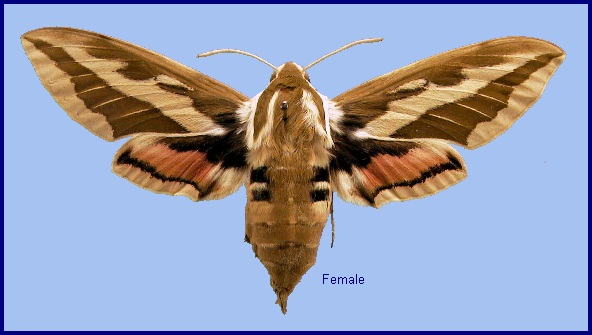
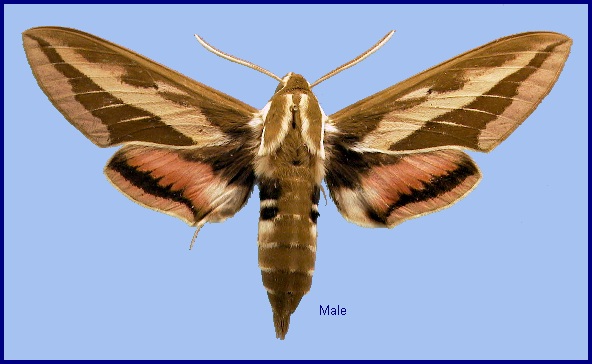
Hyles costata exilis Derzhavets, 1979, Nasekomye Mongolii 6: 408. Type locality: Northern China, Chzhili, Tjan-Tszin [Tianjin].
Synonym. Hyles costata exilis Derzhavets, 1979.
Synonym. Hyles chuvilini Eitschberger, Danner & Surholt, 1998, Herbipoliana 4: 275. Type locality: Russia, Khakasia [Khakasskaya], Abakan, Red Lake, about 53°30'N 91°30'E.
Note. Although the adults are visually very similar, Danner et al. (1998) separated Hyles exilis from Hyles costata (von Nordmann) using small differences in colour pattern and male genitalia. With the discovery of the very dissimilar larvae of both species (V. Dubatolov, pers. comm. 2010; Zolotuhin & Saldaitis, 2011), this separation is justified.
Note. Records of Hyles exilis from Xizang/Tibet and western Yunnan require further study. They may indeed represent an isolated population as there is plenty of suitable habitat and hostplant in these areas (Pittaway, pers. obs. 2013), or indicate a relationship between Hyles nervosa (Rothschild & Jordan) and Hyles exilis.
Wingspan: 70mm. On the lateral side of the first segement of the foreleg there are up to 12 spines (instead of 9 as in Hyles costata) (Derzhavets, 1979).
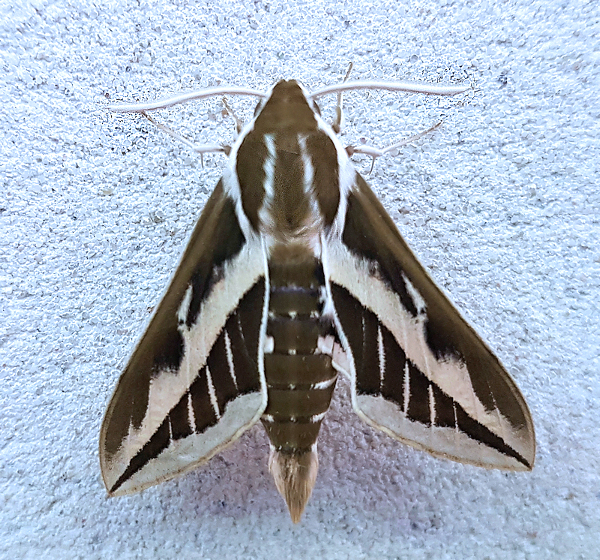
Arid steppe and meadowland (Zolotuhin & Saldaitis, 2011).
China: v (Shaanxi); vi-vii (Tianjin); vi-ix (Shandong); vii (Heilongjiang; Nei Mongol). Mongolia: v (Töv Province; Khovd Province); vi (Gov'-Altai Province); vi-viii (Hèntiy Province); vii (Ömnögov' Province; Bayanhongor Province; Khovd Province). Russia: vi-vii (Transbaikalia); viii (Tuva ASSR).
There are two generations in northern China, with adults flying between June and September (Yang, 1978).
OVUM: Unknown.
LARVA:
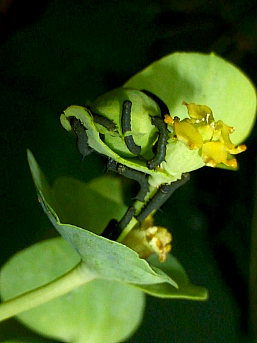
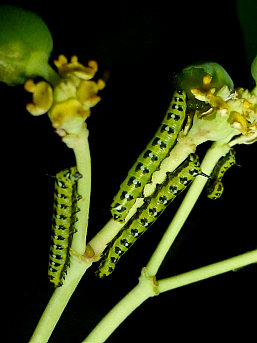
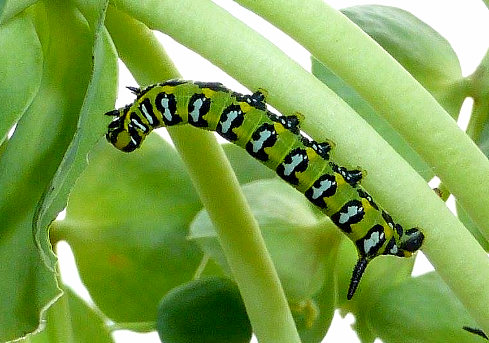
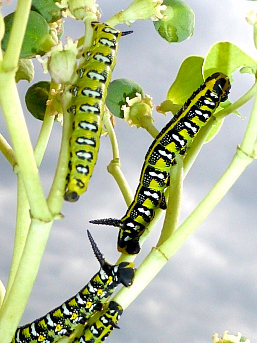
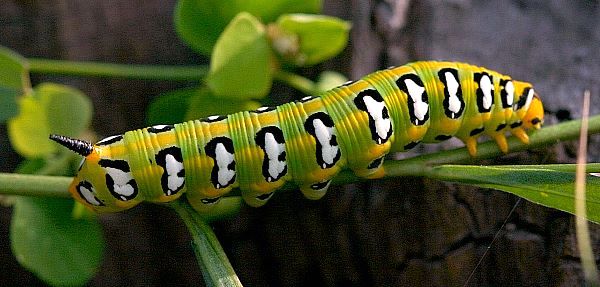
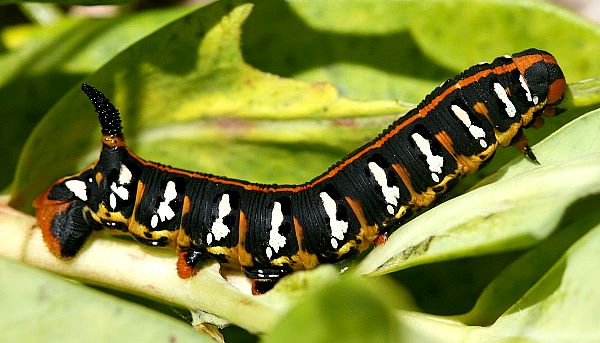
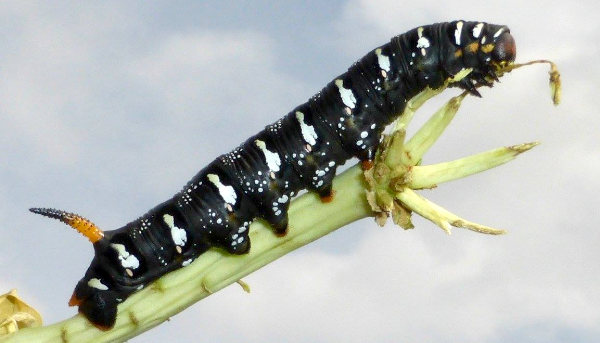
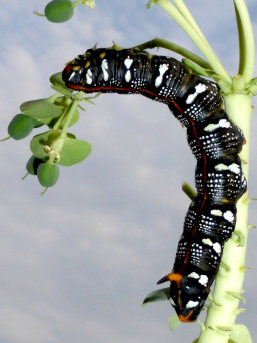
PUPA:
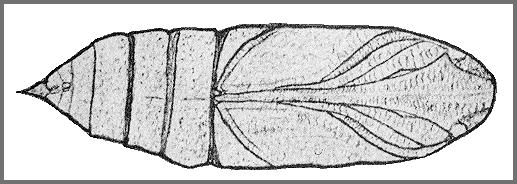

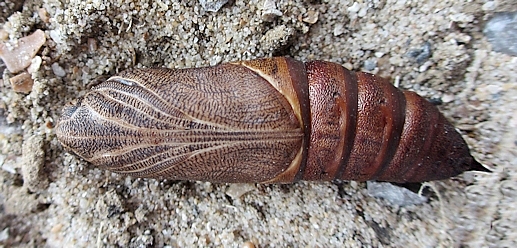
Larval hostplants. The two larvae illustrated from Chita Province (Figs. 5 & 6) were found on Euphorbia fischeri in Transbaikalia (S. Gordeev, pers. comm. 2010; Zolotuhin & Saldaitis, 2011). Similar larvae were also found in the Altai by Derzhavets (V. Dubatolov, pers. comm. 2010), and A.V. Chuvilin collected larvae from a species of Euphorbia by the Yenisey River, Tuva ASSR, Russia (Danner et al., 1998). It has also been recorded from northern China on unspecified Euphorbiaceae by Yang (1978). [The Buryatia larvae were reared on Euphorbia myrsinites by Jurgen Vanhoudt.]
Surprisingly, in July 2021 larvae of this species were also found feeding on Apocynum near Xi'an in southern Shaanxi, China, by Hsia ChungKuei [see iNaturalist].
Unknown.
China: Nei Mongol (80km NE Xin Barag Zuoqi); Heilongjiang (??Buchalu, Xiao Hinggan Ling/Daxing'anling Prefecture, 1100m; Harbin); Hebei (Beidaihe; Shijiazhuang; Baoding); Tianjin (Baxianzhuozi); Beijing; Shandong (Qingdao); Shaanxi (Xi'an; Taibai Shan, 1000m); Henan (Anyang).
Common over the northern half (Loess Plateau) of Shaanxi, China, but absent as a breeding species south of Xi'an/Qinling (Pittaway & Kitching, 2000).
Mongolia Khovd Province (50km W Khovd, 1485m; Bodonchijn River basin, Hundijn River valley, 1600m (46°06'N 92°30'E); 25km NW Mankhan; Sutay Uul Mts (NW slopes); Mongolian Altai (NW slopes), 25km S Tsetseg); Hèntiy Province (90km N Öndörhaan); Ömnögov' Province (Dalanzadgad, Shatiin am; Bayandalai Soum, Khuv, Khaalganii khuudas; Khurmen; Bulgan); Bayanhongor Province (Pitut gol (River) valley); Töv Province (20km NW Tsadmani; Bayankhangai; Ulaan-Baatar); Gov'-Altai Province (Mogoin River, south of Zuyl, 1920m (45°39'N 93°47'E); Mongolian Altai, Alag Kharkhan Mts.); Dundgovi Province (Khuld Soum, Dov Dev; Saikhan-Ovoo); Selenge Province (Tunkhel village, Khailaast).
Russia: Altai SSR (Chemal; Talduir; Kosh-Agach District, Kuraisky Ridge); Khakasskaya SSR (Abakan; Ordzhonikidzevskiy District, near Uzhur; Oglakhty; Minusinsk); Tuva ASSR (Ak-Sug river valley, near Chadan; Buren-Khem; Kaa-Khemskiy District); Buryatia (Kyachta; Ulan-Ude); Transbaikalia (Nizhniy Casuchey; Ononsky district, shore of Lake Balyktui; Daurskii Nature Reserve; Undino-Posel'ye); Amurskaya (Shimanovsk).
Recorded with certainty from Mongolia (Saldaitis & Ivinskis, 2006; Enkhtur, Brehm, Boldgiv & Pfeiffer, 2021; Makhov, Matov & Lukhanov, 2024), northeastern China and adjacent areas of Russia (where it co-occurs with Hyles costata) (Maksimov, Ivanov & Knyazev, 2019), and also farther south in China, in Shaanxi and Shandong (Danner et al., 1998). Interestingly, Zhao & Hu (1987) recorded this taxon (as Celerio costata) from Xigazê (3836m), Gyangzê (4050m) and Yadong (2900m) in Xizang/Tibet, but the specimens in question may be misidentified Hyles nervosa (Rothschild & Jordan) or Hyles livornica (Esper). However, the moth illustrated by Chu & Wang (1982) from Nyalam, Xizang/Tibet, is definitely Hyles exilis (although misidentified as Hyles gallii von Rottemburg). [There is plenty of suitable habitat and hostplant in these areas capable of supporting populations of this species (Pittaway, pers. obs. 2013)].
This species is probably much more widely distributed in northern China, as adults, which could be either this species or Hyles costata, have been recorded from the Chinese Altai (Xinjiang), across Gansu, northern Shaanxi and Nei Mongol, to several more locations in Heilongjiang.
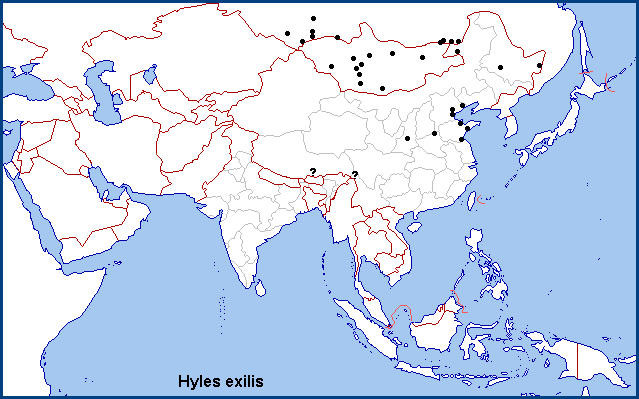
Holarctic; eastern Palaearctic region. Pleistocene refuge: Monocentric -- Sinopacific refugium.
 Return to Sphingidae of the Eastern Palaearctic species list
Return to Sphingidae of the Eastern Palaearctic species list